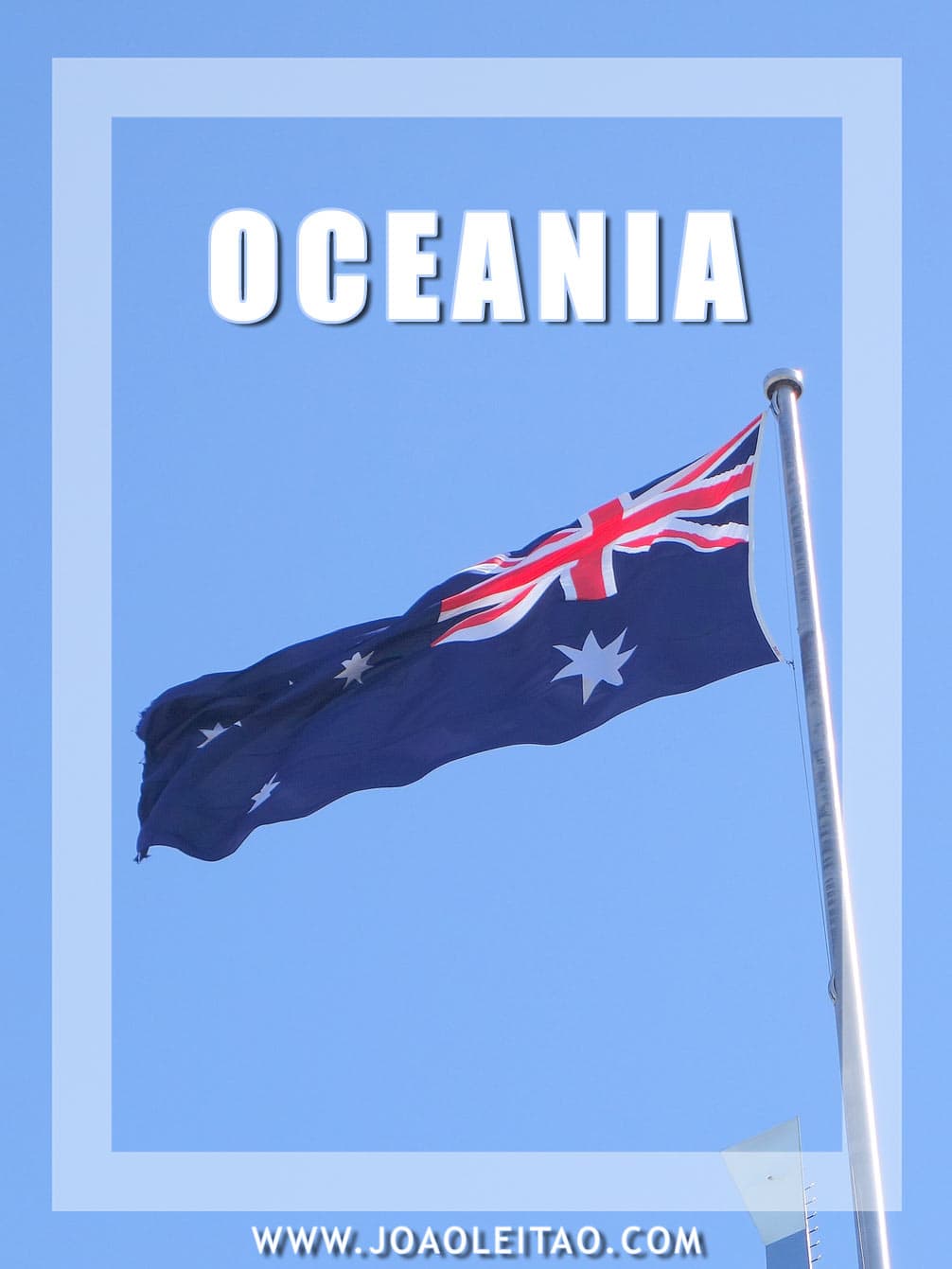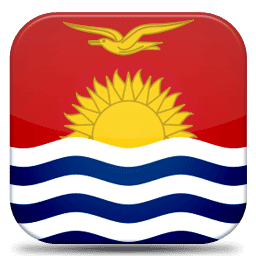Table of Contents

The Oceanian flags represent the national identity of each country. Each color has a meaning in the history of nations. The flags from Oceania vary on color and meaning. On this page, I list all flags of Oceania & Pacific and their colors.
Copyright: I own the copyright usage of these images. You cannot use the text or image without permission.
Oceania National Flags
Alphabetic order

Australia 
Micronesia 
Fiji 
Kiribati 
Marshall-Islands 
Nauru 
New Zealand 
Palau 
Papua New Guinea 
Samoa 
Solomon Islands 
Tonga 
Tuvalu 
Vanuatu
Flags of Melanesia Region
Flag of Fiji

4 colors: azure, dark blue, red, white.
Meaning of the flag of Fiji: Azure stands for the strong relationship of Fiji with the Pacific Ocean that surrounds it. The British Union Jack symbolizes the country’s history as a colony of the United Kingdom. The coat of arms shows the shield of Fiji steadied by two native Fijians who hold weapons, a sailboat above the shield and a banner below which reads “Rerevaka na Kalou ka doka na Tui”, meaning “Fear God and honor the queen”. Across the red band, there is a lion holding a cocoa pod. A cross divides the shield into four sections ornamented with features of Fiji: sugar cane; coconut palm; bananas; a dove of peace holding an olive branch in its beak.
Curiosities about the Flag of Fiji
- Fiji Islands is one of the countries that adopted a flag that clearly shows the historical ties with the United Kingdom, with the Union Jack in the top left corner covering 25% of the whole flag.
- The background is light blue, and there’s a Fiji Island coat of arms in the middle of the right half of the flag, where a British lion holds a cocoa seed in its claws. All other elements relate to the country’s farming industry: a bunch of bananas, sugarcane, a coconut tree, and a white dove flying with an olive branch in its beak.
- The dominant blue stands for the color of the Pacific Ocean that surrounds the Fiji Islands.
- The current flag was adopted after the country’s independence on 10 October 1970. But recently, as it has happened in Australia, there have been some political movements to create a new flag that doesn’t include any elements from the United Kingdom. Former Prime Minister Frank Bainimarama first launched the idea in 2013, but it never moved forward.
Flag of Papua New Guinea

4 colors: red, black, white, yellow.
Meaning of the flag of Papua New Guinea: Black, red and yellow are traditional colors found in Papua New Guinean art and clothing. The yellow stylized bird of paradise represents freedom and the country’s birth as an independent nation. The five stars stand for the constellation the Southern Cross, representing the stars Alpha, Beta, Gamma, Delta and Epsilon (this last one is smaller because it doesn’t shine as brightly as the other stars). The Southern Cross symbolizes the geographical position of Papua New Guinea in the world and its connection to Australia, which also incorporates the Southern Cross on its flag.
Curiosities about the Flag of Papua New Guinea
- This is quite an original flag, with two distinct areas split in half diagonally. On the left, a black background with five white stars. On the right, a red background with the silhouette of a Raggiana Bird of Paradise in yellow.
- The stars represent the Southern Cross constellation, and the bird is Papua New Guinea’s national symbol. The colors have been typically used since ancient times as pigments by local indigenous people and are still very dear to the different tribes that live in the country.
- The flag was adopted in 1971, four years before the independence from Australia. The flag was chosen in a public competition, won by 15-year-old Susan Karike Huhume.
- This is one of the few flags in the world that is shaped like a square.
Flag of Solomon Islands

4 colors: green, blue, white, yellow.
Meaning of the flag of Solomon Islands: Blue is for the water of the Pacific Ocean; the yellow strip symbolizes sunlight; green represents the fruitfulness of the country. The five stars refer to the five governmental territories of Solomon Island.
Curiosities about the Flag of Solomon Islands
- The flag of the Solomon Islands has two horizontal areas divided by a thin diagonal yellow stripe. The top half is blue with five white five-point stars, and the bottom half is green.
- The stars represent the provinces of the archipelago, standing out on the blue that represents the Pacific Ocean. The thin yellow stripe represents the sun, and the green represents the lush green landscapes of the Solomon Islands. Although after their independence the number of provinces in the Solomon Islands increased, the number of stars remains the same as they were at the time they became independent.
- The current flag, chosen a few months before the independence was official, was submitted to a competition by a New Zealander who studied at King George VI at the time although the rules specified that island native was preferred.
- The flag was officially adopted on 18 November 1977.
Flag of Vanuatu

4 colors: red, green, black, yellow.
Meaning of the flag of Vanuatu: Black is for the Melanesian population; red stands for bloodshed; green represents the lush green vegetation and crop growing lands. The emblem is a conventional symbol of prosperity in Vanuatu culture. The thin yellow line inside the black ‘Y’ symbolizes sunshine and Christianity, the most practiced religion of Vanuatu.
Curiosities about the Flag of Vanuatu
- The flag of Vanuatu has a modern and colorful design. On the left side, there’s a black triangle placed horizontally with a thin black stripe that comes from its vertex and splits the flag in half. Inside this black area, there’s a sort of a yellow Y. The rest of the flag is divided into two: top red and bottom green.
- Laid over the black, there’s a graphic representation of a wild boar horn with two branches of a local plant that looks like a palm tree.
- As for the meaning of all these elements, red stands for human blood and the bloodshed by wild boards during sacrifices. The green represents all of Vanuatu, and the black represents the soil and the Melanesian people. The yellow Y represents the archipelago, which is precisely shaped like that letter.
- The branches represent peace and prosperity.
- Symbols aside, the black and yellow elements were added to the flag upon request of then Prime Minister Walter Lini, to add contrast to the background colors.
- The flag is inspired by the local political party Vanua’aku Pati, was designed by local artist Kalontas Malon, and adapted, with some changes after the independence, on 18 February 1980.
Flags of Australia Region
Flag of Australia

3 colors: red, blue, white.
Meaning of the flag of Australia: The flag of Australia has a blue background with the British Union Jack in the upper left corner, representing that the British were the first colonizers coming from Europe. The seven-point star (Commonwealth Star) in white and other five stars (four big and one small) are known as the Southern Cross Constellation. The seven-pointed Star of Federation represents each of Australia’s six states and one additional point represents Australia’s territories. The Southern Cross is a constellation of stars that can be seen from all of Australia’s states and territories.
Curiosities about the Flag of Australia
- Just like with other countries that were once a former British colony, including neighboring New Zealand, Australia’s flag reflects that past by including the Union Jack (the traditional British flag) in its current design.
- Australia’s flag has a blue background, with white stars overlaid that represent the Southern Cross constellation, and the Union Jack in the top left corner covering almost 25% of the whole flag.
- There’s an extra star over the British symbol, one that’s not part of the constellation mentioned above. It’s a seven-point star that stands for the six Australian federal states and the autonomous federal states.
- There was an initial version of the flag, without the seven-point star, chosen among several options in 1901. The current flag was adopted as the official national flag in 1908.
- Currently, Australia debates changing the flag to remove the Union Jack, which some see as a symbolic threat to the country’s autonomy.
- Australian indigenous people have their own flag, similar to the Papua New Guinea one, with two horizontal stripes (black in the top and white in the bottom) and a simple yellow circle in the middle.
Flag of New Zealand

3 colors: red, blue, white.
Meaning of the flag of New Zealand: Blue represents the blue sea and sky. The Union Jack symbolizes New Zealand’s history as a British colony. The four red stars make up the Southern Cross, a constellation of stars, to signify New Zealand’s location in the South Pacific Ocean.
Curiosities about the Flag of New Zealand
- The New Zealand flag looks a lot like the Australian one, with a dark blue background and the United Kingdom’s Union Jack flag covering one-quarter of the flag in the top left corner. It has four five-point stars, red with a white edge, that symbolize the Southern Cross constellation.
- The background blue represents the sky and the ocean you see all around New Zealand.
- This flag was designed by the British Navy first-lieutenant Albert Hastings Markham, who submitted his flag project to governor Sir George Bowen in 1869 for approval.
- Just as it’s been happening in Australia, there has been a movement to replace the current New Zealand flag with one that doesn’t have any British symbols. The issue was brought up for the first time in 1973, but in a referendum in 2016, the voters chose to keep the current design.
Flags of Micronesia Region
Flag of Micronesia

2 colors: blue, white.
Meaning of the flag of Federated States of Micronesia: The color blue in the background stands for the Pacific ocean where the islands are located. The four white stars in the Micronesia flag represent four other islands which make up the Federation together: Chuuk, Pohnpei, Kosrae and Yap.
Curiosities about the Flag of Micronesia
- The Micronesia flag is light blue and has four white five-point stars placed as a triangle in the center.
- The symbolism of the flag is simple: the blue stands for the ocean where the archipelago is, and the four stars represent each one of the islands that make up the country – Chuuk, Pohnpei, Yap, and Kosrae.
- The original flag had six stars instead of four because the Marshall Islands and the Mariana Islands were part of the same political federation, but after those two archipelagos left the federation, the number of stars was adjusted.
- The flag was adopted in 1979 when Micronesia became independent.
Flag of Kiribati

4 colors: red, blue, white, yellow.
Meaning of the flag of Kiribati: The frigate bird flying over the rising sun represents the equator and the blue and white wavy stripes represent the surrounding Pacific Ocean. The bird comes from the country’s coat of arms and represents strength, authority, freedom, and power at sea. The white stripes represent the three island groups: Gilbert, Line, and Phoenix; the 17 rays of the sun represent the 16 Gilbert Islands and Banaba (once Ocean Island).
Curiosities about the Flag of Kiribati
- Perhaps not many people have heard of Kiribati, a small country in Oceania. It’s a tiny archipelago in the middle of the Pacific Ocean, between Australia and South America and it has one of the most original flags in the world. The flag has a red background, a wavy white and blue ocean over it covering the bottom half of the flag, a sun setting and a golden frigate bird flying over it.
- The 16 sunbeams represent the number of islands in the archipelago. The bird represents the connection with the ocean, power, and freedom. Waves, of course, symbolize the Pacific Ocean and the sun stands for the archipelago’s geographical location near the equator line.
- The flag was adopted right after the independence from the United Kingdom in 1979 when the islands’ name changed from the Gilbert Islands to Kiribati. Ironically, the coat of arms was designed by the British, specifically by Sir Arthur Gimble, who created it for the Gilbert and Ellice Islands (as Kiribati and Tuvalu were known at the time).
Flag of Marshall Islands

3 colors: blue, orange, white.
Meaning of the flag of Marshall Islands: The Marshall Islands’ flag represents the country’s geographical position. The stripes indicate that the islands are just north of the equator; the blue area places them in the central north-west Pacific Ocean; the off-center star to the left of the flag places the country slightly west of the international dateline. In more detail, blue symbolizes the Pacific Ocean; orange is a traditional color of the Marshall Islands which represents bravery and wealth; white stands for peace and brightness. The stripes are for the two main chains of the Marshall Islands, the Ralik chain (orange) and the Ratak chain (white). The expanding width of the stripes represents growth and vitality of the country. The star symbolizes each of the 24 municipalities of the Marshall Islands. The four longer points of the star are for the capital city of Majuro, the administrative districts of Kwajalein, Wotji, and Jaluit. These longer points form a cross to symbolize the Christian faith of the Marshall Islands.
Curiosities about the Flag of Marshall Islands
- The Marshall Islands archipelago is located northwest of Australia in the middle of vast Pacific Ocean. Its flag has a dark blue background with two rays coming up from the bottom left corner, stretching out towards the opposite side of the flag.
- The top ray is orange, and the bottom ray is white. There’s a 24-point white star in the top left, with four of the points being larger than the rest (the ones indicating the four cardinal points).
- The 20 shorter star points, or rays, represent the provinces of the archipelago, while the four large ones represent the country’s four main cities: Majuro, Jaluit, Wotje, and Ebeye.
- The orange part of the flag represents the wealth of the islands and the white stands for hope. The predominant blue background represents the Pacific Ocean.
- As with many other flags, this one also stirs up different interpretations. Some texts claim the diagonal stripes represent the equator and the white and red symbolize the sunrise and the sunset, and others claim those are the colors of peace and courage.
- The flag was designed by Emlain Kabua, the wife of the first country’s ruler after independence from the USA in 1979.
Flag of Nauru

3 colors: blue, yellow, white.
Meaning of the flag of Nauru: Blue symbolizes the vast Pacific Ocean and the infinite sky; the twelve-pointed white star is for the twelve unique tribes of the country; the white star symbolizes the location of the nation in association with the Equator. The division into two equal halves recalls the history of the original populace of the nation who originated from two boulders.
Curiosities about the Flag of Nauru
- The flag of Nauru is dark blue, with a thin yellow stripe across and a 12-point white star on the left of the lower half.
- The meaning of the star is peculiar. It doesn’t represent the number of regions or islands, unlike other flags in Oceania, but the number of indigenous tribes that used to live there despite two of them no longer exist.
- The yellow stripe represents the equator line, and the star is on the same location as the island in regards to that line, just one degree to the south.
- The blue stands for the ocean around Nauru, while the white of the star stands for phosphate, the small country’s biggest natural resource.
- The flag was chosen during a public competition and adopted on the country’s independence day, 31 January 1968.
Flag of Palau

2 colors: blue, yellow.
Meaning of the flag of Palau: The light blue stands for the sovereignty and freedom achieved by Palau. Blue can also stand for the Pacific Ocean.The yellow full moon represents peace and the time for activities because the people of Palau consider the full moon to be sacred and ideal for plantation and harvesting.
Curiosities about the Flag of Palau
- The flag of Palau is light blue with a yellow circle that appears to be in the center, but it’s actually placed slightly on the left.
- The blue represents the Pacific Ocean, and the yellow circle stands for the full moon, something that has a mythical significance to Palau’s locals. They believe that certain activities like fishing or harvesting have higher chances of success when done during a full moon.
- This flag, designed by John Blau Skebong, was adopted on 1 January 1981 when Palau became semi-independent under the protection of the USA.
Flags of Polynesia Region
Flag of Samoa

Flag of Samoa
3 colors: red, blue, white.
Meaning of the flag of Samoa: Red stands for courage; blue means freedom; white is for purity. The five stars are associated with the constellation of the Southern Cross identifying Samoa’s geographical position in the world map and its connection with New Zealand, which also has the Southern Cross on its national flag.
Curiosities about the Flag of Samoa
- The flag of Samoa is mostly red, with a blue rectangle with five white five-point stars in the top left corner, which covers about 25% of the flag. As with many other flags in this part of the world, the stars represent the Southern Cross constellation, visible in Samoa’s night sky.
- The red stands for the bloodshed during the independence wars throughout the German occupation (1900-1914), although the country spent more time under New Zealand ruling (1914-1962).
- The flag first appeared in 1949, only with four stars at the time, but the final version appeared shortly after and became the flag of independent Samoa in 1962.
Flag of Tonga

2 colors: red, white.
Meaning of the flag of Tonga: The Red Cross represents the arrival of Christianity to Tonga islands. The color red in the largest portion also has religious connotations, the blood of Christ and his sacrifice. The white quarter stands for purity.
Curiosities about the Flag of Tonga
- The flag of small Tonga is one of the oldest flags in the continent, going back to 1863 and being part of the Kingdom’s Constitution since 1875 as unchangeable. It’s entirely red with a white square in the top left corner, with a red cross inside.
- It’s a religious flag where the red stands for the blood of Christ and the cross stand for Tonga’s residents’ faith. The white is a reference to purity.
- The flag was created by Taufa’ahau Tupou, a tribal leader who had been converted to Christianity shortly before he became King George Tupou I in 1849. There was the first flag, with a white background and two red crosses, that was replaced after in Tonga they found out the flag was too similar to the Red Cross one.
Flag of Tuvalu

5 colors: azure, dark blue, red, yellow, white.
Meaning of the flag of Tuvalu: The Tuvalu Flag has the Union Jack, the flag of the UK to represent the link maintained to date after a past dependency. The nine islands of the country are present in the nine stars.
Curiosities about the Flag of Tuvalu
- The flag of Tuvalu is very similar to the flags of Australia and New Zealand: light blue background, with the Union Jack (the United Kingdom’s flag) covering ¼ of the flag in the top left corner. On the right half of the flag, there are nine yellow five-point stars.
- The blue stands for the Pacific Ocean, the stars represent the number of inhabited islands in the archipelago, and the Union Jack represents, of course, the connection of Tuvalu to the United Kingdom, from which it became independent in 1978.
- Between 1996 and 1997 the country used a flag without the Union Jack, which caused negative feedback from the population, who suspected the change of the flag meant the country would become a republic and replace the traditional monarchy. Because of those events, the flag was reinstated.
















